(37,137 statute miles ; 59,766 km)
This year marked a change, in that our cyclone season base moved on from New Zealand where we had been for three years, westwards on our circumnavigation path, to Australia. We arrived in Bundaberg on the Queensland coast just after dusk on Sunday 30th October after a magnificent, SE trade wind passage of 1041nm. However, first we had to escape from NZ north through the notorious autumnal, Kiwi, maritime weather. Conditions were much worse than usual and one of the slots we chose not to chance, turned into a nightmare when at least five boats on the way north to the islands were lost in a storm. All the crews were saved. Two weeks later we managed a fast, if somewhat robust passage to Lautoka on Fiji's west coast. There we stayed for three weeks entertaining Kiwi visitors before heading out the 460nm to Vanuatu.
Our landfall on a lea shore at Port Resolution on the island of Tanna was dramatic with 35+kts of wind and intense tropical rain destroying visibility but Amoenitas's 95hp engine saw us safely through to the shelter of an isolated shallow bay of refuge. When Cpt. James Cook first named it after his boat, the anchorage was 5m deeper but Vanuatu is a geologically active area of volcanoes and uplifting landmasses. One is immediately struck by the culture change from the Polynesian peoples we had experienced so far in the Pacific to their slimmed down cousins of Melanesian origin. They are extremely friendly but very poor with virtually all transport outside the only two towns based on simple dugout canoes.

Life for most Ni Vanuatu is fairly basic with a home constructed of natural materials with sustenance grown in gardens, augmented by fish for those within easy reach of the sea. The staple crops are yam, cassava, tapioca, cabbage and beans, along with fruits such as bananas, papaya (pawpaw) and those wonderful large, often pink, pampelmousse (grapefruit) we had come to know and love in French Polynesia. They consume a particularly strong form of kava which forms the basis of the most of the male population's focus when the sun descends.

Back now to Tanna where day one required a two hour drive by truck over rough tracks to the check in port of Lenakel. The only good road was the stretch below over the ash fallout from the active volcano, Mount Yasur. A couple of days later we were lucky enough to get a truck up a theme park like ride to within 500m of the summit just before dusk fell.
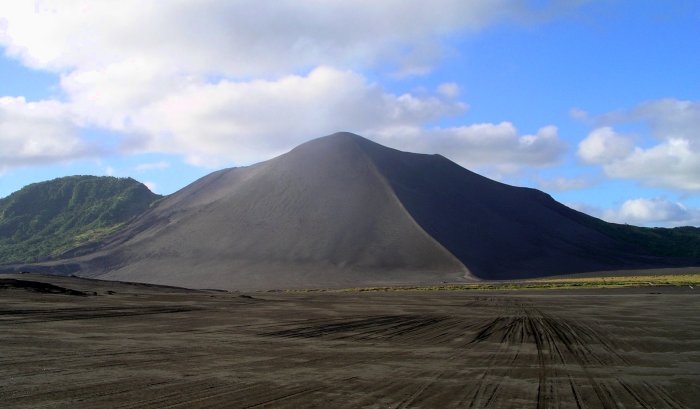
From a vantage point on the rim of the crater we observed regular eruptions on around a 2-3 minute cycle spanning the dwindling light into complete darkness. Being this close to such an immense and sudden release of energy is a truly awesome experience (Kiwi's note). Not until a large mass of red hot rock fell on the periphery of the lower crater rim just below us did we realise what a 'close to the edge' experience this was. About ten weeks after we were there the activity level increased to the point where visitors were no longer allowed to the crater rim.
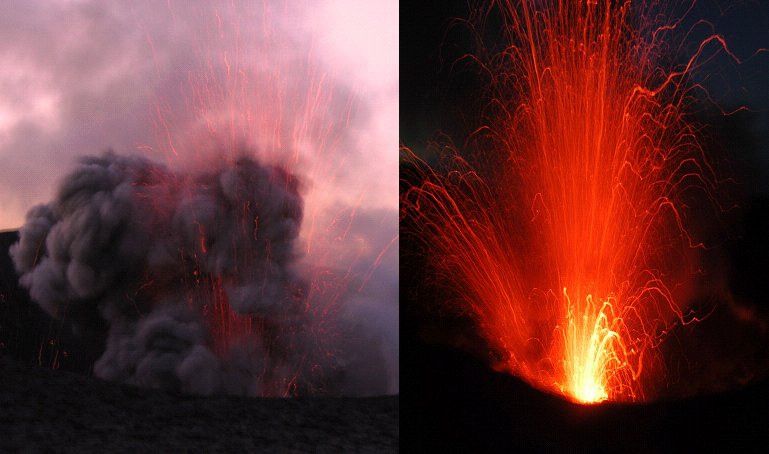
From Tanna we sailed south to Aneityum, Vanuatu's most southerly island which at over 20°S was noticeably cooler. The water temperature was around 25°C, quite bracing after Fiji and way below the 31°C we experienced later 600km further north. Nevertheless, the waters there were superbly clear, giving us our first experience of the fantastic marine life that abounds in this beautiful country. From there, a long sail north to Efate and the capital Port Vila where we undertook the essential task of acquiring our visas to visit Australia. Aside from the US territories of the US Virgin Islands & Puerto Rico, this is the only one of the 32 countries we have visited to date on our voyage that require a visa before making landfall.
Below, the ladies of Vila market are trading in instant local takeaway foods. This stall specialises in a tart based on banana, further on is the traditional favourite, hot laplap based on tapioca. Note the total absence of man made packaging, banana and other leaves used to wrap and palm leaf based simple baskets for bulkier root crops. They are wearing the loose fitting 'Mother Hubbard' style dresses introduced by the early missionaries.

Vila is one of only two settlements we might call towns in the whole of Vanuatu and the only one that has anything like the range of services one might require. The French influence from the times of the condominium of shared rule with Britain has left a legacy of high prices but some good restaurants (The country achieved independence on 1st Aug 1980). The harbour is charming and affords good shelter, plus some unexpected extras in the form of wrecks to dive on. Below is the first Dave visited with cruising mate, also a Dave from Nordlys. This fishing boat lay in 30m just outside the harbour and was a feature for a great Sunday lunchtime sailing visit which also coincided with our 40th wedding anniversary.
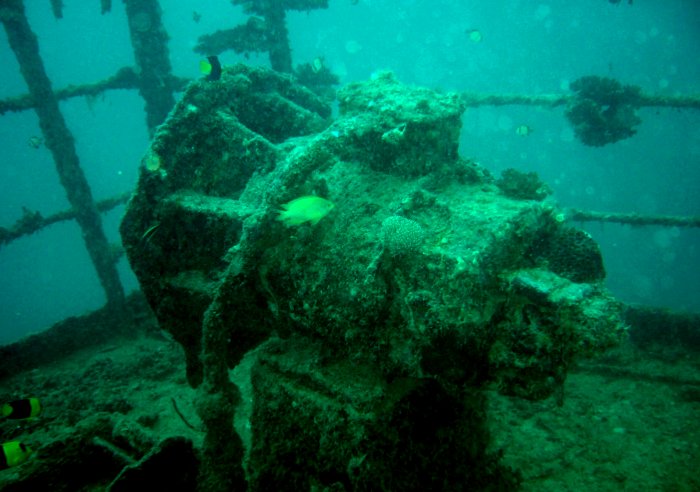
There were two more wrecks to be dived within Port Vila harbour. The Star of Russia, an 89m long, iron-hulled clipper ship lies upright in 35m. That was in an area of restricted visibility but was home to a myriad of fish species including large groupers. The second, a huge Sandringham flying boat, a derivative of the Sunderland which had been operated by Qantas. At a depth 40m within the inner harbour the visibility was limited to around a couple of metres but it was possible to get this flash image through the broken cockpit screen of what remains of the back of the pilot's control panel.
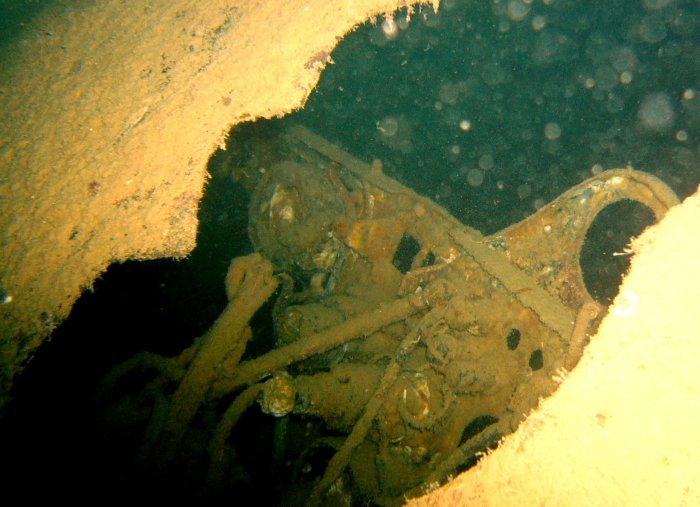
The factor which most strongly differentiates rural Vanuatu from other communities of the South Pacific is the richness and strength of the traditional culture. Villages throughout the land vie to demonstrate this to groups of passing cruisers, at a price of course. The itinerant fleet of yachties has become the only reliable source of cash income available in remote areas. More than this, they have come to rely on us to bring in spares, repair things like water systems and even transport essential items like rice, flour and fuel.
Here a group perform one of their kastom dances for us in a screened off area, as tradition demands that none of their women are allowed to observe. They are of the Small Namba grouping of tribes on the south west coast of Malekula in a very beautiful group of low lying islands called the Maskelynes. A strict grading structure delineates a man's status in the tribe, here there are typically 19 nimangki grades. However, on the same main island there are 35 grades in South West Bay but only 3 important ones in Vao. The women have a similar but less demanding grading process called namanggitenge.

Most people still believe strongly in the spirits or devils as they are known in the local Bislama language. Traditional male attire comprises only one leaf of dried fibre around the penis, tucked into a bark belt. The women wear short raffia grass skirts and are topless but for a headdress of purple pandanas fibres extending down to their hips. Normally of course they are in shorts, T-shirts and dresses but the old ways are alive and well, not just dusted down for tourists. The last recorded victim of cannibalism went into a Big Namba ground oven on Malekula in 1969.
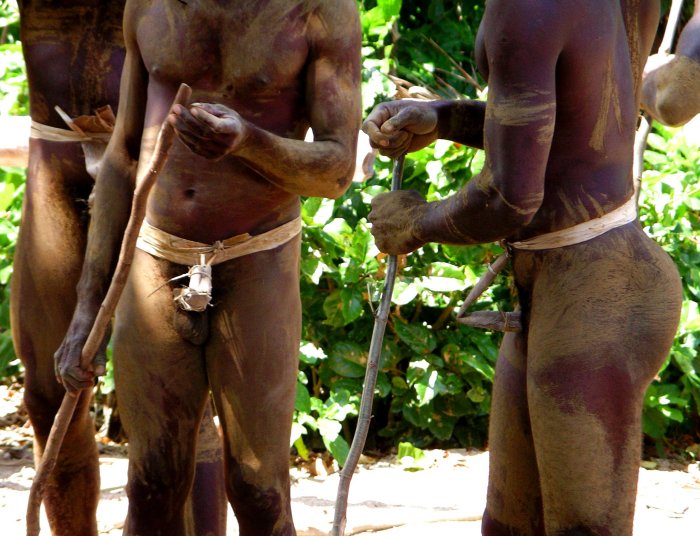
Handicrafts also feature strongly in Ni-Vanuatu culture with the island of Ambrym being the centre of a rich carving tradition. The figures below are tamtams which when complete with their hollowed out slot in the base are beaten as ceremonial drums. Ideally made from the breadfruit tree, they can have one or more stylised human faces with accentuated eyes and as here, several rows of pyramidal spikes. The skill of the carver is often rated by the number of rows he can achieve. The designs of virtually all the traditional carvings are the subject of intellectual property rights, a fee paid in pigs or more commonly now cash being paid to a family or tribe.

These Rom dancers, also from Ambrym perform one of the most striking annual traditional ceremonies. The north of the island is steeped in elements of magic and tabu resulting in the costumes being burned after use to prevent the spirit taking over, haunting or impersonating the wearer. Sorcery abounds still and its practitioners are treated with great respect, being referred to in Bislama as "man blong majik" or "man blong posen". Official notices in the language appear very quaint to us and are almost decipherable.
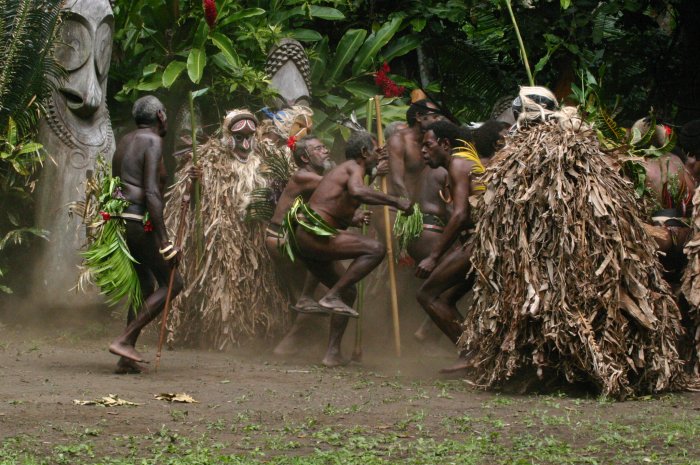
Women seem to play a less central role in most traditional ceremonies, mostly performing together as below. Note the tamtams dominant role representing ancestors or gods and the long slot at the mouth of the sounding box. Dancers often carry smaller tamtams around a metre long that accompany the chanting to maintain the beat. The one under shade has special significance and may be a sea god with a fish carved near its base. It also is the only one we have seen with painted features.
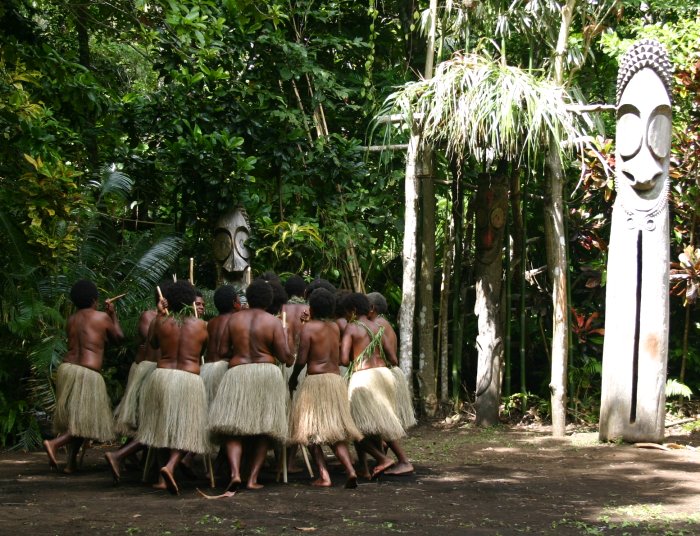
Each Rom costume, normally a thick cloak of banana leaves with a tall conical, brightly coloured banana fibre mask represents a specific spirit. The one below is typical and seems to appear in similar forms right across Melanesia to Papua New Guinea.

The Kiwi's would have us believe that bungee jumping was begun by A J Hackett at the Kawaru suspension bridge just outside Queenstown. However, the menfolk of southern Pentecost have being doing it for many centuries using supple vines rather than man-made elastic. The tradition is said to come from Tamalie who pursued his wife up a banyan tree, following her as she jumped. Yes, she was the one attached by vines! Nowerdays it has significance in ensuring a good harvest of the staple yam crop by the foreheads of the jumpers touching the earth. A full sized tower rises vertically for 16m then leans back.

Only men dive, beginning at the age of eight. The youngest goes first, usually from a point someway down the tower. Divers are supposed to choose their own vines which are tied by friends. Before they leap they throw back their arms and cry out to the crowd below their most intimate thoughts (as it may be their last). The soil of the steeply inclined landing area is well loosened and the jumper springs back onto it but there is little room for error. Several are injured and occasionally killed.
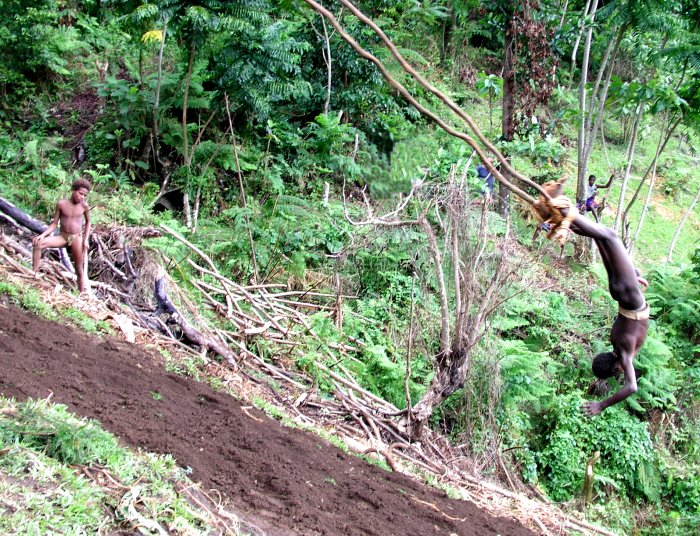
One of our favourite anchorages was within shallow reefs in clear waters off the charming little village of Loltong. The scene below is so typical of Ni-Vanuatu life with dogs, chucks and children moving around in the heat of the day whilst adults sit around in groups doing craft work or chatting.
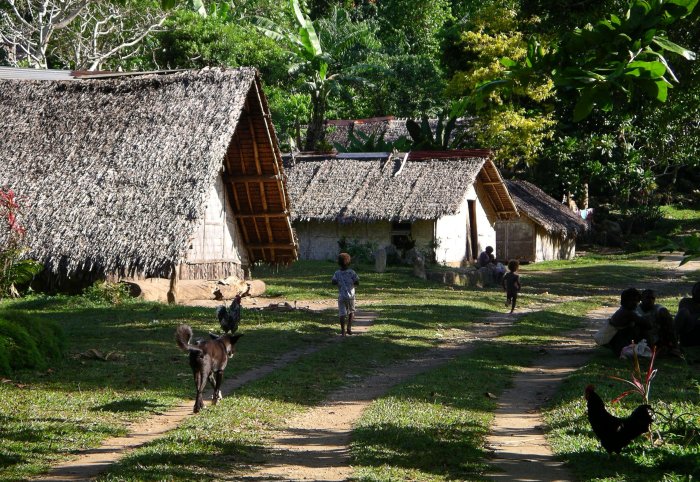
Most villages have a large communal building, called a nakamal, mostly empty awaiting a meeting or event but not so at Loltong. Their's is at the hub of communal life where meals are cooked, where people often alone can find somewhere to sleep and where there is a cordoned off 'women free zone' at the end where the men consume kava as darkness draws in. There was even a fire there being kept alight for 100 days to mark the passing of a family member.
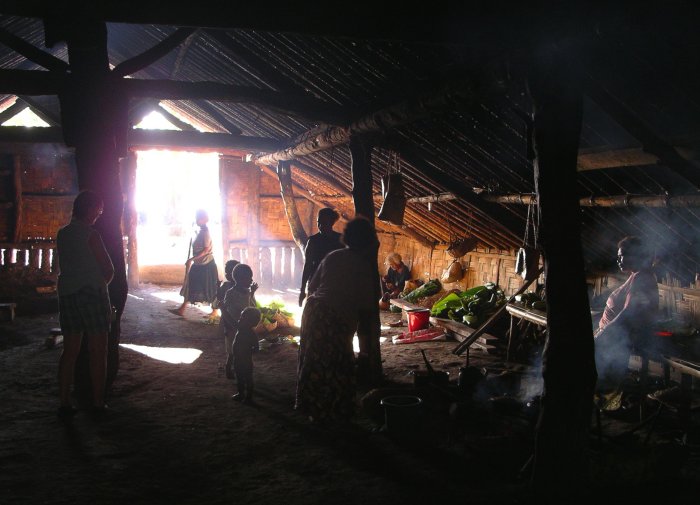
Just north of Pentecost is another long thin island, Ambae and on its SW corner a sheltered bay at the village of Asanvari. This a mecca for we cruisers as the village is very yachtie friendly to the point where the local baker delivers bread each morning in his outrigger canoe. Until that is, the flour runs out when we arrange for the next cruiser coming out from one of the centres to bring more 15kg bags. The snorkeling and diving on the south of the bay is excellent and afterwards you and your equipment can wash off under this delightful waterfall jut 25m from the beach.

Under chief Nelson and son Nixon the local villages have embraced we itinerant sailors and with the help of a Peace Corp volunteer have constructed a large 'yacht club' which also doubles as their communal meeting hall. There you can get an tasty dinner of local lobster, fresh water prawns or fish. Below they are performing their kastom dances in the club for us.

Not to be outdone by their parents, the school children united on the occasion of an inter-village soccer tournament to give a concert of dancing, singing, mime and plays (in Bislama). Here is a group miming to popular music. We discover that Bob Marley and similar style singers are the top of the pops here.

From Ambae it was 60nm across to Espiritu Santo, the final island we were to visit. On its SE shore, within a group of three sheltering islands is Luganville, the second and only other town worthy of the name in Vanuatu. This was the site of a enormous Allied logistics, fighter and bomber base in World War II. After the attack on Pearl Harbour the Japanese rapidly moved south to capture all the territories down from the Phillipines to Solomon Islands and by mid-1942 were in a position to threaten Australia and the remainder of the Pacific Islands. It was the actions in Guadalcanal and Santa Cruz, launched and supported from Santo 500nm (900Km) to the south that reversed the Japanese thrust.
For the three years preceding September 1945 more than 500,000 people passed through this tiny community which grew from around 500 permanent residents to over 50,000. At the end of 1945 the US withdrew dumping thousands of tons of bulldozers, cranes, jeeps, trucks, forklifts, dredges, etc. along with crates galore of engines, spares, tyres and supplies down to tens of thousands of coca cola bottles. This was all driven into the sea and pushed off the reef at a place now known as Million Dollar Point.

Drivers jumped off vehicles heading seaward which were helped on their way by bulldozers with coral infill used to preserve a ramp. The remains now form a chilling monument to the stupidity and futility of war. Just think what a valuable resource this quantity of construction and transportation equipment would have been to such an under developed country, particularly after they had been imposed upon to become a military base.

Sixty years on it is an amazing sight with much of the hardware recognisable from spare batteries to entire bomber aircraft undercarriages. As can be seen the tyres seem particularly well preserved. Had Dave known he would have taken a tyre pressure gauge with him on this dive down to about 35m.
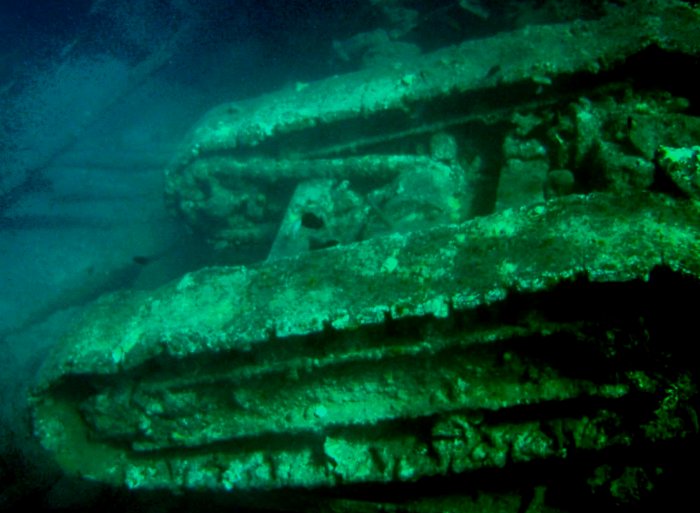
One of the treats Dave had been most looking forward to in Vanuatu was the opportunity to dive one of the world's most famous wreck sites. At 09.35am on the morning of 26th October 1942 the SS President Coolidge, a US troopship with 5050 troops and 340 crew aboard hit two US laid mines on the approach to the Segond Channel leading to Luganville. Captain Henry Nelson ran the ship aground on the reef but within 85 minutes she turned onto her port side, sliding back off the reef to come to rest with the bow in 25m (80ft) and stern in 70m (230ft). Amazingly only two souls were lost, one artillery officer and one of the engine room crew.

Diving any wreck can be dangerous but entering the bowels of a vessel to depths of 50m through confined passages in an area with frequent earth tremors entails special care. The wreck is only divable with a professional guide as the site has claimed several lives. The 'Two Daves' as we became known by Allan Powers's excellent organisation completed four dives over a wide area of the hull down to 50m with Richard our Aussie supervisor. At these depths a typical dive was 25 minutes 'bottom time' with another 25-30 minutes decompression at 12 and 6m on the way up. As we squeezed through confined gaps in total darkness, other than the beam of our underwater torches, we were ever aware that our first mistake would probably be our last.

One needed to continually keep in mind the fact that the wreck lay on its port side so that which was horizontal had started life vertically. So a dive began with a downward traverse along the starboard side of the hull and usually ended by approaching the bow along the vertical face of what was the deck. Because the sinking occurred in a pretty remote place, well before the development of scuba gear, much of the site has been relatively undisturbed as illustrated by some of the many helmets and rifles dropped by troops as they ran for the ladders down the sides of their stricken transport.
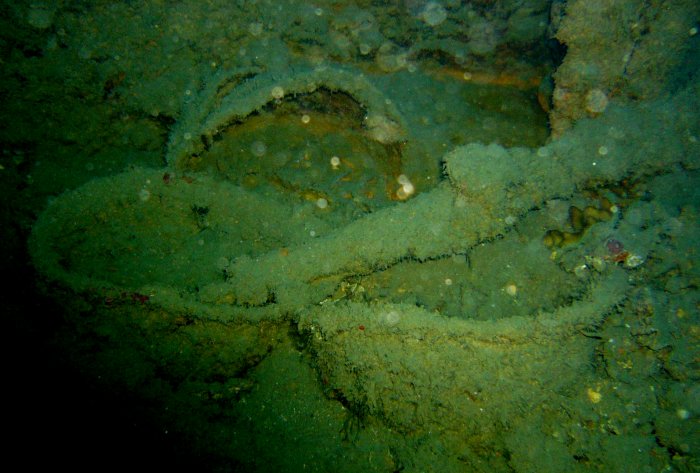
The light fitting below from the 1st class dining room looks in relatively good condition to the point where some of the pattern etched onto the glass is still discernible. Remember it was at 90° to the image here which we rotated for ease of viewing.

In No. 1 hold were howitzers, tanks, tens of aircraft underwing fuel tanks and many jeeps. The front of this Willeys jeep with radiator grill and light unit are readily recognised. We also visited the engine room, medical surgery and many of the staterooms, often gaining access through broken bulkheads or ventilation ducts.
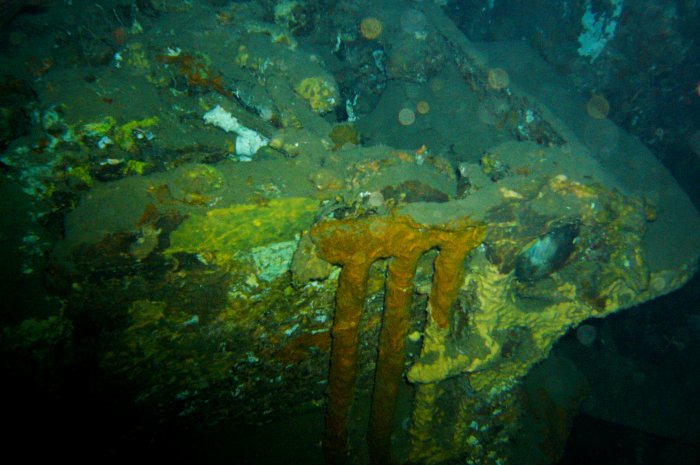
The most famous artifact on the wreck is known as 'The Lady'. She along with her accompanying unicorn formed the centrepiece of a huge frieze above the fireplace in the 1st class smoking and gaming room. She had to be moved to a new site at about 46m when her original home was threatened by collapse. It is a tradition that divers remove their mouthpiece and kiss the lady to pay respect to the wreck.
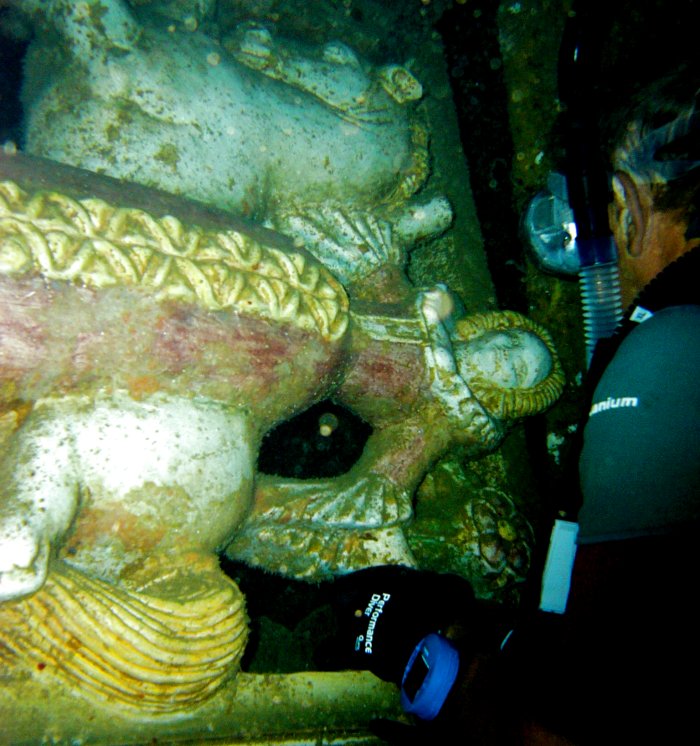
Before we finish our tale for this season, we'd like to share a wonderfully stimulating experience we had whilst walking back towards our anchorage just outside the town at Luganville. As we were passing the gates of the main high school at lunchtime we heard peels of laughter and saw close to the gate a gathering of what appeared to be the entire school. They were being entertained glittering style by a trio of acrobats/jugglers/mime artists named Nez A Nez from the neighbouring territory of New Caledonia. It was wonderful to observe the response of the children to this classic French Cirque maintaining the links to the Anglo/French condominium.

Where to next:-
We will stay here in Bundaberg for a week of sailing rally festivities with lots of old and new 'mates' before heading down to Brisbane via Mooloolaba where we have two more sailing re-unions. In Brisbane we will be based at the Scarborough Marina where we are expecting visits from several groups of UK and Kiwi friends. We'll buy a car and set about learning yet another lot of geography. We expect to be in this neck of the world for several years so can pace ourselves in exploring this huge continent.
When the cyclone season is over next May, the plan is to head east back to the tropical islands where we hope to spend six months exploring the atolls and reefs of New Caledonia. Then a return to Oz and maybe a journey south down the east coast to Tasmania.